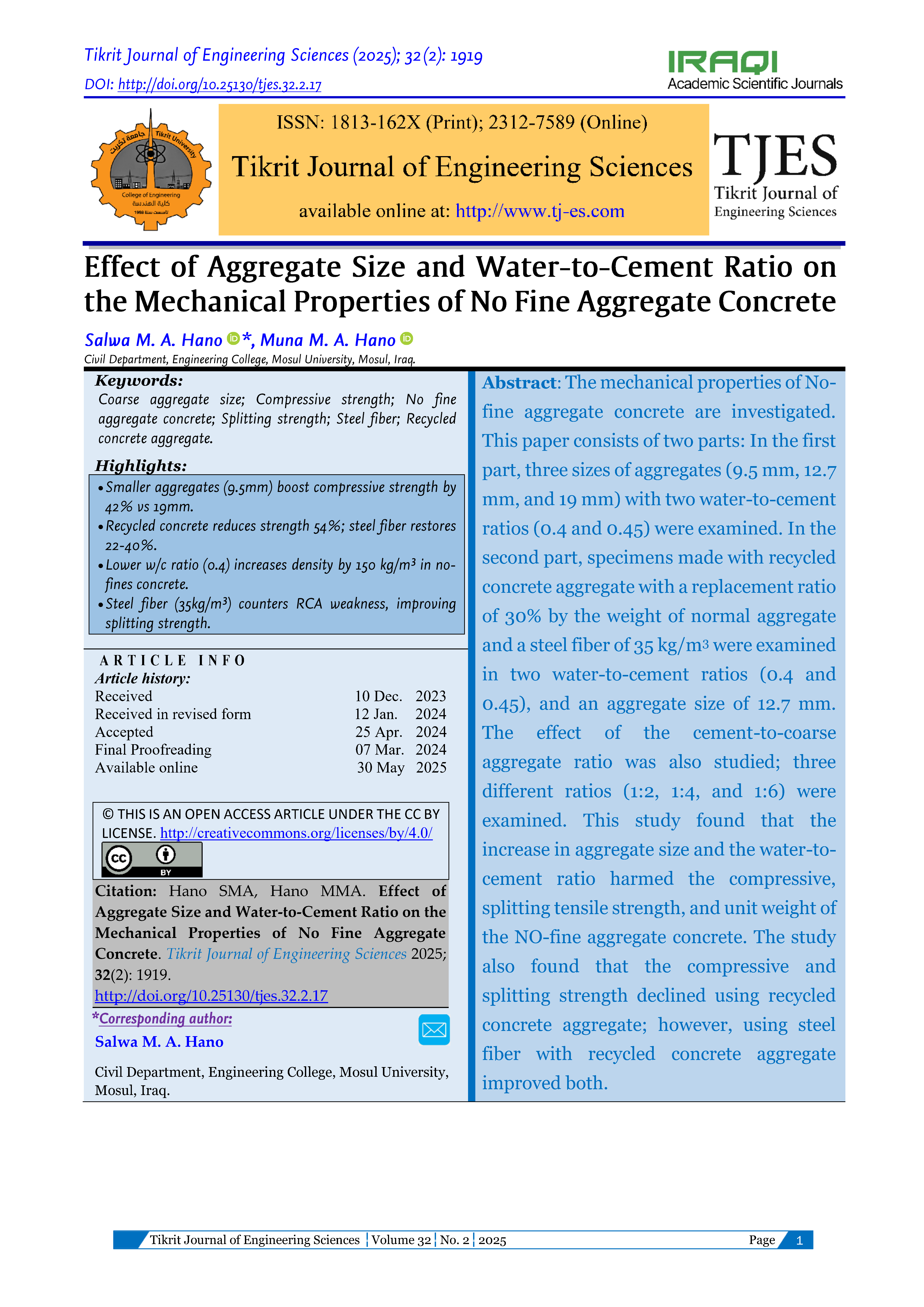Effect of Aggregate Size and Water-to-Cement Ratio on the Mechanical Properties of No Fine Aggregate Concrete
محتوى المقالة الرئيسي
الملخص
The mechanical properties of No-fine aggregate concrete are investigated. This paper consists of two parts: In the first part, three sizes of aggregates (9.5 mm, 12.7 mm, and 19 mm) with two water-to-cement ratios (0.4 and 0.45) were examined. In the second part, specimens made with recycled concrete aggregate with a replacement ratio of 30% by the weight of normal aggregate and a steel fiber of 35 kg/m3 were examined in two water-to-cement ratios (0.4 and 0.45), and an aggregate size of 12.7 mm. The effect of the cement-to-coarse aggregate ratio was also studied; three different ratios (1:2, 1:4, and 1:6) were examined. This study found that the increase in aggregate size and the water-to-cement ratio harmed the compressive, splitting tensile strength, and unit weight of the NO-fine aggregate concrete. The study also found that the compressive and splitting strength declined using recycled concrete aggregate; however, using steel fiber with recycled concrete aggregate improved both.
تفاصيل المقالة
القسم

هذا العمل مرخص بموجب Creative Commons Attribution 4.0 International License.
THIS IS AN OPEN ACCESS ARTICLE UNDER THE CC BY LICENSE http://creativecommons.org/licenses/by/4.0/
المراجع
Maguesvaria MU, Narasimha VL. Studies on Characterization of Pervious Concrete for Pavement Applications. Procedia - Social and Behavioural Sciences 2013; 104:198-207.
Ghafoori N, Dutta S. Laboratory Investigation of Compacted No-Fines Concrete for Paving Materials. Journal of Materials in Civil Engineering 1998; 7(3).
Schaefer VR et al. An Overview of Pervious Concrete Applications in Storm Water Management and Pavement System. Iowa State University; 2006.
US Environmental Protection Authority. Storm Water Management Handbook. 2009; 45.
Kuennen T. A New Era for Porous Pavement: Better Road for the Government Project. 2003.
Abadjieva T, Sephiri P. Investigations on Some Properties of No-Fines Concrete. 2000.
Rehman HAA. Some Properties of Fiber Reinforced No-Fine Concrete. Al-Qadisiya Journal for Engineering Sciences 2012; 5(4):439-450.
Thombre KB. Investigation of Strength and Workability in No-Fines Concrete. International Journal of Engineering Research & Technology 2016; 5(9):390-393.
Patil PS, Sonar IP, Shinde S. No-Fine Concrete. International Journal of Concrete Technology 2017; 3(2):1-13.
Al-Luhybi A, Al-Sulayfani B. Strengthening and Rehabilitation of Concrete Prisms Using GFRP Sheet. Al-Rafidain Engineering Journal 2020; 25(1):17-23.
Iraqi Standard Specifications. Portland Cement. I.Q.S No.5; 2010.
Iraqi Standard. Water for Making Concrete. I.Q.S No.1703; 2016.
ASTM International. Standard Test Method for Density, Absorption, and Voids in Hardened Concrete. *ASTM C642-13*; 2013.
British Standards Institution. Method for Determination of Compressive Strength of Concrete Cubes. BS 1881 Part 116; 1989.
Geissert DG, Li SE, Frantz GC, Stephens EJ. Splitting Prism Test Method to Evaluate Concrete-to-Concrete Bond Strength. ACI Materials Journal 1999; 96(3): 359-366.





